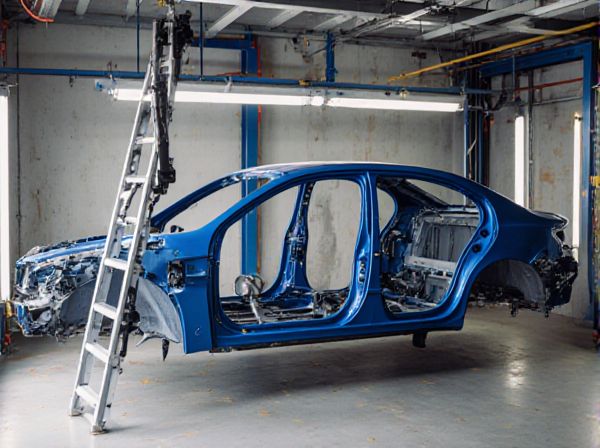
Photo illustration: Ladder Frame vs Perimeter Frame
Ladder frames offer superior durability and are ideal for heavy-duty vehicles due to their simple, strong design consisting of two longitudinal rails connected by cross members. Perimeter frames enhance vehicle handling and ride comfort by following the outer edges of the body, providing better weight distribution and a lower center of gravity. Your choice depends on whether off-road strength or on-road performance is a higher priority.
Table of Comparison
| Feature | Ladder Frame | Perimeter Frame |
|---|---|---|
| Structure | Two longitudinal rails connected by crossmembers | Rails run around vehicle perimeter with crossmembers inside |
| Weight | Heavier | Lighter |
| Strength | High torsional rigidity for heavy loads | Moderate rigidity, optimized for passenger safety |
| Application | Trucks, SUVs, off-road vehicles | Passenger cars, sports cars |
| Ride Quality | Less smooth due to heavier frame | Smoother ride with improved handling |
| Cost | Lower manufacturing cost | Higher manufacturing cost |
Introduction to Frame Types: Ladder vs Perimeter
Ladder frames consist of two longitudinal beams connected by multiple cross members, providing strong support and durability for heavy-duty vehicles. Perimeter frames, also known as "ring frames," follow the vehicle's outer edges, enhancing rigidity and improving crash safety for passenger cars. Both frame types influence vehicle weight, handling, and structural integrity, making frame selection critical for performance and application.
Structural Design Differences
Ladder frames feature two longitudinal beams connected by several lateral cross members, offering a simple and robust structure ideal for heavy-duty vehicles and off-road applications. Perimeter frames, designed with side rails that follow the outer edges of the vehicle's body, provide improved torsional rigidity and better crash protection by integrating more closely with the vehicle's chassis. The key structural difference lies in ladder frames prioritizing load distribution along straight beams, whereas perimeter frames enhance strength through a more enclosed, rigid boundary that supports modern unibody designs.
Material Composition and Construction
Ladder frames are traditionally constructed using high-strength steel, featuring two longitudinal rails joined by multiple cross members that provide enhanced rigidity and durability for heavy-duty applications. Perimeter frames, often made from high-strength steel alloys or aluminum, emphasize a boxed construction that wraps around the vehicle's body, offering improved torsional resistance and weight savings for better handling. The material composition and construction techniques impact vehicle performance, with ladder frames prioritizing robustness and perimeter frames focusing on structural efficiency and weight reduction.
Weight and Durability Comparison
Ladder frames are generally heavier due to their robust, box-section steel construction, which provides excellent durability and resistance to twisting, making them ideal for off-road and heavy-duty applications. Perimeter frames, lighter in weight, surround the vehicle's floor pan with boxed sections that enhance rigidity and contribute to better handling and fuel efficiency while still offering adequate durability for typical road use. The trade-off between weight and durability favors ladder frames for extreme durability, whereas perimeter frames strike a balance by reducing weight without significantly compromising strength.
Performance Impact on Vehicles
Ladder frames provide superior strength and durability, making them ideal for off-road vehicles and heavy-duty trucks where structural rigidity is crucial. Perimeter frames enhance handling and ride comfort by lowering the center of gravity, benefiting passenger cars with improved cornering stability and reduced body roll. The choice between ladder and perimeter frames directly affects vehicle performance characteristics such as torsional stiffness, weight distribution, and impact resistance.
Safety Considerations and Crashworthiness
Ladder frames provide robust structural integrity with high torsional rigidity, enhancing crashworthiness in off-road and heavy-duty vehicles by effectively absorbing impact forces during collisions. Perimeter frames offer improved energy dissipation in side-impact crashes due to their wider design that encircles the vehicle's passenger compartment, increasing occupant protection. Both frame types impact overall vehicle safety, but perimeter frames generally provide better side-impact protection, while ladder frames excel in frontal crash scenarios and load-bearing durability.
Cost Analysis: Manufacturing and Maintenance
Ladder frames generally incur lower manufacturing costs due to their simpler design and widespread production techniques, making them a budget-friendly choice for heavy-duty vehicles. Perimeter frames, while more complex and expensive to produce because of enhanced structural components, offer improved safety and rigidity that can reduce long-term maintenance expenses. Maintenance costs for ladder frames tend to be higher over time due to their susceptibility to corrosion and frame twisting, whereas perimeter frames benefit from better durability and ease of repair, offsetting initial investment with lower lifecycle costs.
Application in Vehicle Categories
Ladder frames are predominantly used in heavy-duty vehicles like trucks and SUVs due to their superior strength and ability to handle heavy loads and rough terrains. Perimeter frames are favored in passenger cars and light-duty SUVs for their enhanced rigidity, crash protection, and improved handling characteristics. The choice between ladder and perimeter frames depends on vehicle category requirements such as load capacity, off-road capability, and safety standards.
Pros and Cons of Ladder Frames
Ladder frames offer exceptional durability and strength, making them ideal for heavy-duty trucks and off-road vehicles due to their ability to withstand high torsional stress. They provide easier repairs and customization, as the separate frame design allows for simpler modifications and replacement of parts. However, ladder frames tend to be heavier, resulting in reduced fuel efficiency and less responsive handling compared to perimeter frames, which are designed for improved ride comfort and stability in passenger cars.
Pros and Cons of Perimeter Frames
Perimeter frames offer enhanced rigidity and improved side-impact protection due to their design, which wraps around the vehicle's exterior. They provide better weight distribution and contribute to a lower vehicle center of gravity, improving handling and stability. However, perimeter frames tend to be heavier and more complex to manufacture, which can increase production costs and reduce fuel efficiency compared to ladder frames.
 caratoz.com
caratoz.com